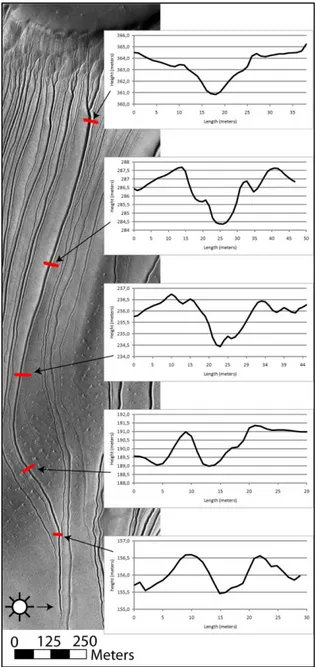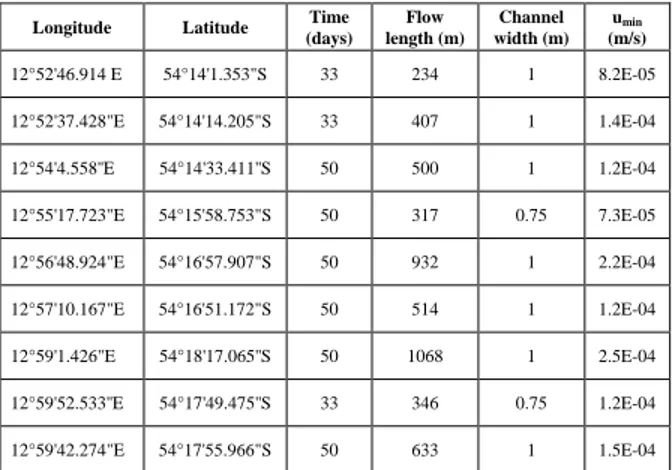HAL Id: hal-01713643
https://hal.archives-ouvertes.fr/hal-01713643
Submitted on 20 Feb 2018HAL is a multi-disciplinary open access
archive for the deposit and dissemination of sci-entific research documents, whether they are pub-lished or not. The documents may come from teaching and research institutions in France or abroad, or from public or private research centers.
L’archive ouverte pluridisciplinaire HAL, est destinée au dépôt et à la diffusion de documents scientifiques de niveau recherche, publiés ou non, émanant des établissements d’enseignement et de recherche français ou étrangers, des laboratoires publics ou privés.
GEOMORPHIC STUDY OF DEBRIS FLOWS ON
THE RUSSELL DUNE (MARS) : COMPARISON OF
DEBRIS FLOWS AND PRESENT FLOWS ACTIVITY
Gwenael Jouannic, J. Gargani, F. Costard, G. Ori, C. Marmo, Frédéric
Schmidt
To cite this version:
Gwenael Jouannic, J. Gargani, F. Costard, G. Ori, C. Marmo, et al.. GEOMORPHIC STUDY OF DEBRIS FLOWS ON THE RUSSELL DUNE (MARS) : COMPARISON OF DEBRIS FLOWS AND PRESENT FLOWS ACTIVITY. 42nd Lunar and Planetary Science Conference, Mar 2011, The Woodlands, United States. �hal-01713643�
GEOMORPHIC STUDY OF DEBRIS FLOWS ON THE RUSSELL DUNE (MARS) : COMPARISON OF DEBRIS FLOWS AND PRESENT FLOWS ACTIVITY. G. Jouannic1,2, J. Gargani1, F. Costard1, G. G. Ori2, C.
Marmo1 and F. Schmidt1, 1IDES, Université Paris-Sud 11, CNRS/INSU UMR 8148, bât. 509, 91405 Orsay, France
(gwenael.jouannic@u-psud.fr), 2IRSPS, Università G. d’Annunzio, Viale Pindaro 42, 65127 Pescara, Italy.
Introduction : Liquid water is not likely to be found
on the surface of Mars because of atmospheric pres-sure/temperature conditions below water’s triple-point. However, the discovery of gullies suggests that signif-icant amounts of liquid water has flowed on Mars in a recent past [1].
This study focus on morphology of gullies over dunes on the Russell crater (54.5°S ; 12.7°E). Recent numer-ical simulations have shown that sinuous shapes of these Martian gullies over dunes can be better repro-duced with liquid-water-bearing flows [2]. The dis-covery of debris flows on sand dunes is unexpexted and the origin of the fluid necessary for the formation of debris flows remains currently a mystery.
Recent work shows that the gullies located on the Russell dune are not only extremely youthfull but seem also to be still active [3]. This study aims to : 1/ realize a morphological description of the debris flows of the Russell dune and the Present flow activity using the HiRISE images ; 2/ estimates the physical proper-ties of the flows (velociproper-ties, flow rates) and the maxi-mum grain size of the dune surface material ; 3/ use the different flow morphologies and the calculated parameters to compare the debris flows and the Present flow activity.
Russell debris flows : A total of about 300 long and
narrow gullies are observed on the western SW flank of the Russell megadune over a total area of 20 km large. Using the HiRISE DEM of the Russell dune and classic hydrogeologic equations, the flow velocity of Russell gullies have been estimated (Figure 1). Considering that the flow velocity v can be calculated using the Manning-Strickler equation : v = K Rh2/3 S1/2
where K, Rh and S are the Manning coefficient, the
hydraulic radius and the channel slope respectively, we estimate the flow rate Q of a martian debris flow. The flow rate decrease along the slope (Table 1).
Table 1. Ds : distance
of the cross section from the source of the debris flow. Summary of the velocities (v) and flow rates (Q) calcu-lated along the studied debris flow.
Figure 1. Position of the five cross sections studied along the
gully. HiRISE image PSP_007229_1255 on the left. We observe a decrease of the flow velocity along the same chan-nel moving away form the source of the debris flow.
Present flow activity : Several Present seasonnal
flows activities were observed in early spring from ~Ls 190° to 220° in the 28 M.Y. and 29 M.Y. This Present activity can generate sinuous (sinuosity index > 1,1) and branching morphologies of new channels with incision into the dune surface (Figure 2). Some-times, the formation of a low albedo area may
accom-DS Channel slope S (m/m) Velocity v (m/s) Flow rate Q (m3 /s) 340 0.15 12.4 425 857 0.12 9.4 420 1251 0.12 7.2 183 1591 0.14 9.4 153 1846 0.08 4.1 29 1734.pdf 42nd Lunar and Planetary Science Conference (2011)
panied the Present flow activity. The minimum esti-mated velocities of these flows is calculated thanks to the length of the new flows and the time spent between the two observations. Also, velocities calculated range from 10-5 to 10-4 m.s-1. Using these minimum flows velocities and grains threshold transport (shields stress), the maximum estimated grain size range from 16 µm to 1100 µm.
Longitude Latitude Time (days) Flow length (m) Channel width (m) umin (m/s) 12°52'46.914 E 54°14'1.353"S 33 234 1 8.2E-05 12°52'37.428"E 54°14'14.205"S 33 407 1 1.4E-04 12°54'4.558''E 54°14'33.411''S 50 500 1 1.2E-04 12°55'17.723"E 54°15'58.753"S 50 317 0.75 7.3E-05 12°56'48.924"E 54°16'57.907"S 50 932 1 2.2E-04 12°57'10.167"E 54°16'51.172"S 50 514 1 1.2E-04 12°59'1.426"E 54°18'17.065''S 50 1068 1 2.5E-04 12°59'52.533''E 54°17'49.475''S 33 346 0.75 1.2E-04 12°59'42.274"E 54°17'55.966"S 50 633 1 1.5E-04
Table 2. Position of the Present flows activities on the
Rus-sell dune and parameters used to estimate the minimum flow velocity (umin).
Figure 2. Zoom on the distal part of the defrosting area, a
change in gully morphology is visible between PSP_00326_1255 and ESP_012213_1255 images. A small channel grew ~145 m (marked by a appearance of low albe-do zone on ESP_012213_1255) within a larger pre-existing channel.
Discussion and conclusion : Independently of
previous studies and using new methods, we estimate the velocity of martian debris flows and Present flows as well as grain size diameter of the Russell dune. The individual debris flows of the Russell dune are slightly sinuous, have lengths of about 2 km along gentle slopes (5-20°) and widths between 3-20 m. Moreover, we observe the occurence of lateral deposit
(levees) exceeding 1 m thickness on each side of the channels. The estimated flow velocities (4.1-12.4 m.s
-1
) are in the range of previous estimation using other methods [2] and indicate a significant viscosity (40-1040 Pa.s). The small grain size estimated (16 µm to 1100 µm) allow us to understand that the viscous flow easily incorporate the material of the dune. The solid content of the debris flow is large and explain the significant development of lateral deposit. The debris flow velocity is not constant along the slope. The app-roximative time necessary to flow along the dune is comprised between 175 s and 525 s. This could be possible for a ''mixed'' water/solid flow [4].
The Present flow activity generates more branching morphologies, with small sinuous channels (~1 m width) not visible on the DEM HiRISE and a large low albedo area (~70 m) bordering channels. This area may be a defrosting zone causing by the melting of water ice or the sublimation of CO2 ice at the end of winter.
Contrary to the individual debris flows, there is no visible lateral deposit bordering Present flow, maybe due to too low image resolution.
The slow estimated velocities of the Present flows could be due to our method of calculation. Indeed, we use HiRISE images of the Russell dune at different time. The relatively long time between two observati-ons (minimum of 33 days) could explain the low flow rate. Velocities of these flows are certainly faster and obsevrations closer in time would allow to obtain results more similar to observed slow terrestrial flows (~0.5 m.s-1). A water liquid content during 33 days seems not realistic under present Martian conditions. The most likely mechanism in the formation of sinuous dune debris flows is the melting of near-surface groundice at high obliquity [5], [6] or under current climatic conditions [7].
The morphology of Present flow is clearly different from the debris flow of the Russell dune. A different process in the flow formation related to the disappearance of seasonal CO2 ice and water ice at
early spring on the dune surface [8] could generate these new morphologies. Nevertheless, the question remains : did these two morphologies (debris flows and Present flows activity) generate by different processes ? Or may the repetitiveness of seasonal flows over time cause the formation of individual debris flows ?
References: [1] Malin, M.C. and Edgett, K.S. (2000), Science, 288. [2] Mangold, N. et al. (2010), JGR, 115 (E11001). [3] Reiss, D., et al. (2010), GRL, 37 (L06203). [4] Chevrier, V.F. et al. (2009), JGR, 114 (E06001). [5] Costard, F. et al (2002), Science, 295. [6] Mangold, N. et al. (2003), JGR, 108 (E4). [7] Reiss, D. and Jaumann, R. (2003), GRL, 30 (6), 1321. [8] Gardin, E. et al. (2010), JGR, 115 (E06016).
1734.pdf 42nd Lunar and Planetary Science Conference (2011)

